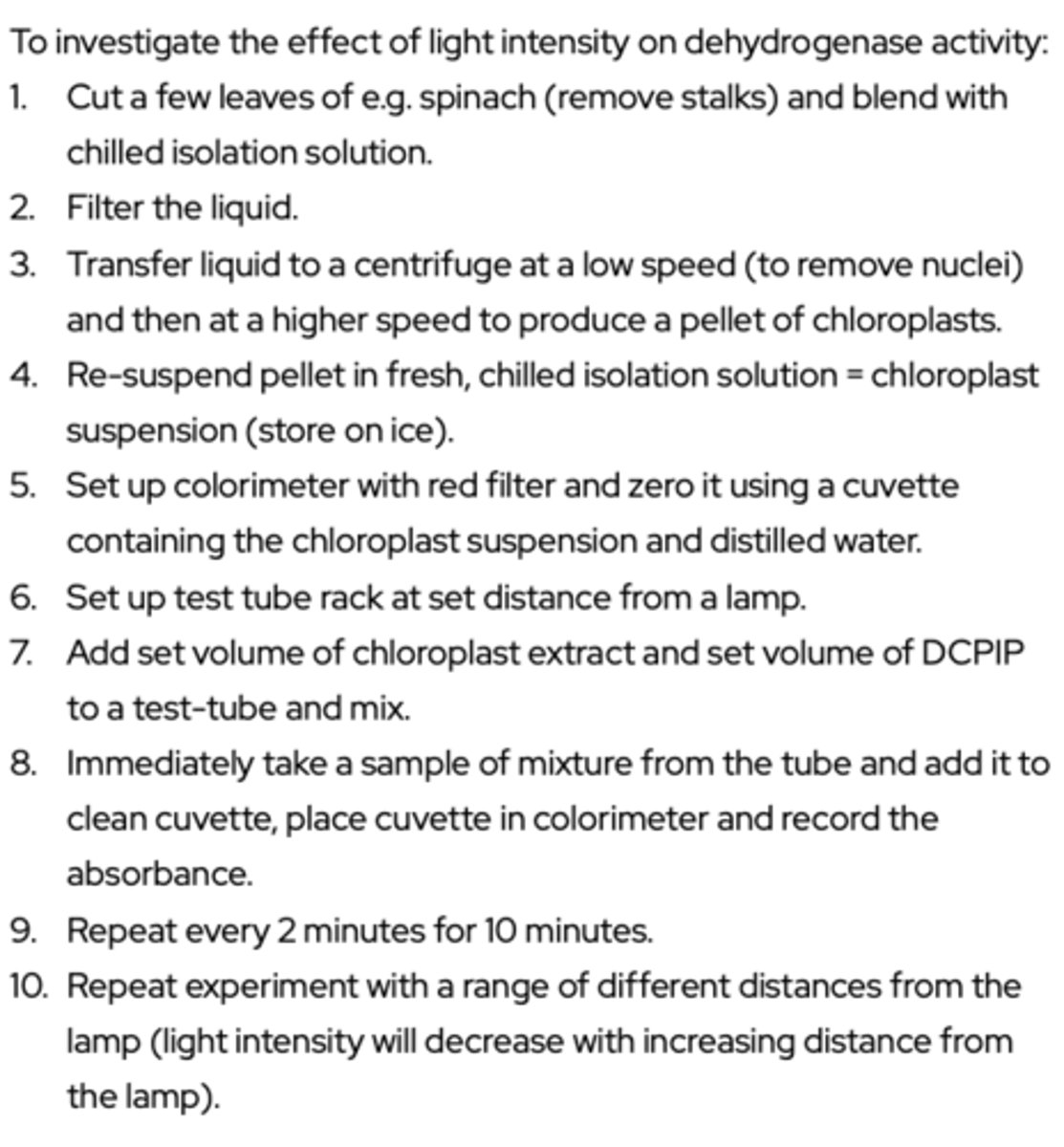RP8: Investigation into the effect of a named factor on the rate of dehydrogenase activity in extracts of chloroplasts
1/24
There's no tags or description
Looks like no tags are added yet.
Name | Mastery | Learn | Test | Matching | Spaced |
|---|
No study sessions yet.
25 Terms
What is the method for this experiment? (10)

What is the role of NADP in the light-dependent reaction of photosynthesis? (1)
NADP is reduced to reduced NADP
What type of enzyme catalyses the light-dependent reaction of photosynthesis? (1)
A dehydrogenase enzyme
What is DCPIP and its role in photosynthesis experiments? (2)
- DCPIP is a redox indicator dye.
- It acts as an electron acceptor in the electron transport chain
What happens to DCPIP when it is reduced? (1)
It changes from blue to colourless
How can the rate of dehydrogenase activity be measured in photosynthesis experiments? (1)
By measuring the rate at which DCPIP changes from blue to colourless
What happens to absorbance as DCPIP is reduced? (1)
Absorbance decreases
What does a faster rate of absorbance decrease indicate? (1)
A higher dehydrogenase activity.
What are the two negative control samples required for investigating the effect of light intensity? (2)
1. A sample containing only DCPIP and a chilled isolation solution (no chloroplast extract).
2. A sample containing both DCPIP and chloroplast extract but wrapped in tinfoil to prevent light exposure.
What should be observed in the control samples? (1)
No change in absorbance
Which variables should be controlled in the experiment? (4)
- Source of chloroplasts
- Volume of chloroplast suspension
- Concentration of DCPIP
- Volume of DCPIP
Why should the extraction solution be cold, buffered, and isotonic? (3)
- Cold: To slow/stop enzyme activity.
- Buffered: To prevent changes in pH that could denature enzymes.
- Isotonic: To maintain the same water potential as the chloroplasts, preventing osmosis and chloroplast bursting
Write a suitable null hypothesis for this experiment. (1)
Light intensity has no effect on the time taken for DCPIP to change colour
Which statistical test should be used and why? (1)
Student's t-test, because it is used to compare two means
Why was the leaf stalk not used when preparing the chloroplast pellet? (1)
Fewer chloroplasts are present in the stalk, and the tougher material does not blend easily
What is the purpose of blending the leaves? (1)
To break open cells and release chloroplasts
Why does the liquid need to be filtered? (1)
To remove cell walls and other debris
Why should leaves be blended for no longer than 15 seconds? (2)
- To release the chloroplasts without damaging them.
- To prevent excessive heating
Why does DCPIP change colour? (2)
- DCPIP is reduced when it accepts electrons from the electron transport chain.
- This causes it to change from blue to colourless
What is the purpose of control 1 in the experiment? (2)
- To show that chloroplasts are required for the reaction.
- To confirm that light alone does not cause DCPIP to decolourise
Why does DCPIP in control 2 stay blue? (2)
- The foil prevents light from reaching the chloroplasts.
- No electrons are released from the chlorophyll, so no reduction of DCPIP occurs
Why would DCPIP not decolourise if the chloroplast suspension had been boiled? (2)
- Boiling denatures the proteins in the electron transport chain.
- Electrons cannot pass along the chain to reduce DCPIP
Where in the chloroplast does the transfer of electrons from chlorophyll take place? (1)
Thylakoid membrane
How do some weed killers work by affecting photosynthesis? (3)
- They slow the light-dependent reaction, reducing NADP and ATP production.
- Less GP is converted to TP.
- Fewer useful organic molecules are synthesised.
How could the method be adapted if no colorimeter was available? What is a limitation of this adaptation? (2)
- Adaptation: Prepare a colour standard (tube containing only chloroplast suspension & water) for comparison.
- Limitation: The end-point is subjective, even with a colour standard